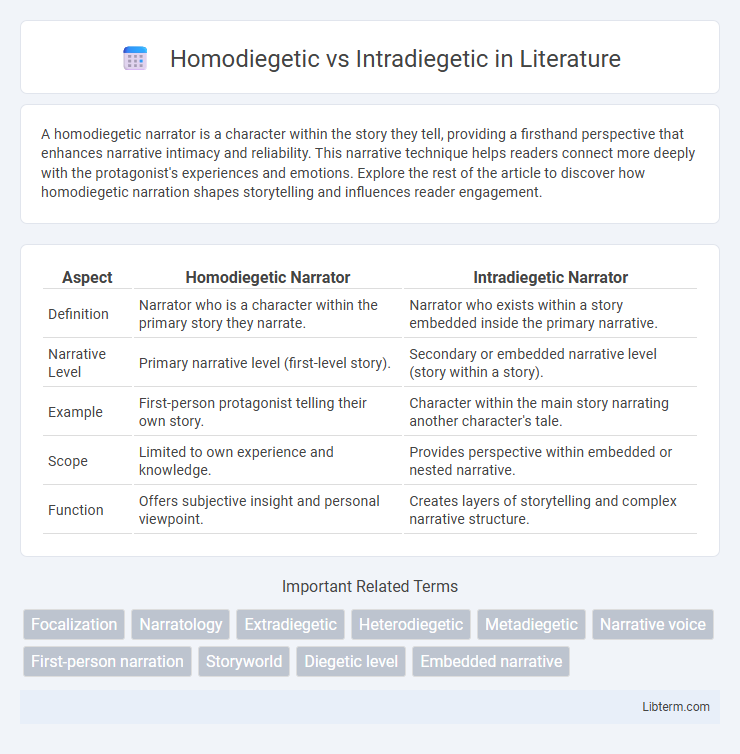A homodiegetic narrator is a character within the story they tell, providing a firsthand perspective that enhances narrative intimacy and reliability. This narrative technique helps readers connect more deeply with the protagonist's experiences and emotions. Explore the rest of the article to discover how homodiegetic narration shapes storytelling and influences reader engagement.
Table of Comparison
| Aspect | Homodiegetic Narrator | Intradiegetic Narrator |
|---|---|---|
| Definition | Narrator who is a character within the primary story they narrate. | Narrator who exists within a story embedded inside the primary narrative. |
| Narrative Level | Primary narrative level (first-level story). | Secondary or embedded narrative level (story within a story). |
| Example | First-person protagonist telling their own story. | Character within the main story narrating another character's tale. |
| Scope | Limited to own experience and knowledge. | Provides perspective within embedded or nested narrative. |
| Function | Offers subjective insight and personal viewpoint. | Creates layers of storytelling and complex narrative structure. |
Introduction to Homodiegetic and Intradiegetic Narration
Homodiegetic narration occurs when the narrator is a character within the story they tell, providing a subjective perspective that offers insight into personal thoughts and experiences. Intradiegetic narration refers to a narrative voice located within the story's world, including both homodiegetic narrators and other narrators embedded in the narrative frame. Understanding the distinction between homodiegetic and intradiegetic narration clarifies narrative levels and the relationship between the storyteller and the story, crucial for analyzing narrative reliability and focalization.
Defining Homodiegetic Narrators
Homodiegetic narrators are characters within the story they tell, providing a first-person perspective that offers direct access to their thoughts and experiences. They contrast with intradiegetic narrators, who narrate from within the story world but may not be primary characters or may narrate parts of the narrative. Defining homodiegetic narration involves recognizing the narrator's dual role as both participant and storyteller, which influences narrative reliability and subjectivity.
Understanding Intradiegetic Narrators
Intradiegetic narrators are storytellers who exist within the narrative world they describe, often participating as characters in the events they relate. This type of narration contrasts with homodiegetic narrators, who also appear inside the story but are specifically the first-person narrators recounting their own perspective. Understanding intradiegetic narrators is crucial for analyzing narrative layers, as they provide an internal viewpoint, offering insights into the story's subjective reality and influencing the reader's interpretation of the plot and other characters.
Key Differences Between Homodiegetic and Intradiegetic
Homodiegetic narrators are characters who participate in the story they tell, providing first-person perspectives within the diegesis. Intradiegetic narrators encompass all narrators existing inside the story world, including homodiegetic narrators as well as narrators telling embedded or secondary narratives within the primary narrative. The key difference lies in homodiegetic narrators being specific participants in the main narrative, while intradiegetic narrators include any narrative voice located inside the diegesis, whether primary or nested.
Narrative Levels: Exploring Diegetic Layers
Homodiegetic narrators participate in the story they tell, existing within the narrative level they describe, which creates a direct diegetic layer involving their own experience. In contrast, intradiegetic narrators tell stories nested within the primary narrative, introducing secondary diegetic layers that enrich the narrative structure by embedding tales within tales. Analyzing these narrative levels reveals how diegetic layers function to deepen reader engagement through complex storytelling techniques and perspective shifts.
Functions of Homodiegetic Narrators in Fiction
Homodiegetic narrators, who are characters within the story's world, provide a subjective perspective that enhances emotional engagement and deepens character development. Their presence allows for reliable or unreliable narration, influencing readers' interpretation of events and creating layers of meaning through personal biases and limited knowledge. This narrative function enriches fiction by fostering intimacy between the narrator and audience while shaping the story's focalization and internal coherence.
Role of Intradiegetic Narrators in Storytelling
Intradiegetic narrators actively participate in the story world, offering firsthand perspectives that enhance authenticity and emotional depth in narrative delivery. Their presence within the plot allows for a subjective interpretation of events, providing audiences with insight into character motivations and internal conflicts. By embedding the narrator inside the narrative universe, intradiegetic storytelling fosters immersive engagement and a nuanced understanding of the story's thematic elements.
Literary Examples of Homodiegetic Narration
Homodiegetic narration occurs when the narrator is also a character within the story, offering a subjective perspective, as seen in Charlotte Perkins Gilman's "The Yellow Wallpaper," where the first-person narrator reveals her psychological descent. Similarly, in F. Scott Fitzgerald's "The Great Gatsby," Nick Carraway's homodiegetic narrative provides an insider's account while maintaining personal biases. This narrative style deepens character development and creates a complex interplay between narrator and plot, distinguishing it from intradiegetic narration where the narrator is part of a story within the main narrative.
Comparative Analysis: Homodiegetic vs Intradiegetic Effects
Homodiegetic narrators participate as characters within the story, offering a subjective perspective that enhances emotional engagement and reliability based on their personal involvement. In contrast, intradiegetic narrators exist within the narrative level but do not always participate as characters, allowing for a broader, sometimes more objective viewpoint that can reveal multiple facets of the story's diegesis. Comparative analysis reveals that homodiegetic narration intensifies reader immersion through internal subjectivity, while intradiegetic narration provides versatility in storytelling by bridging narrative layers without breaking the diegetic universe.
Conclusion: Choosing the Right Narrative Perspective
Selecting between homodiegetic and intradiegetic narrative perspectives hinges on the degree of narrator involvement and audience engagement desired. Homodiegetic narration offers an intimate, subjective viewpoint by placing the narrator within the story world, fostering a strong emotional connection. Intradiegetic narration, by contrast, situates the narrator inside the narrative realm but distinct from the protagonist's perspective, maintaining narrative reliability while allowing deeper exploration of multiple viewpoints.
Homodiegetic Infographic

 libterm.com
libterm.com